The Asti Palio is not just another horse race. In Asti , an ancient, mid-sized town in northwestern Italy, the annual Palio is laden with tradition, pageantry, exuberance, gloom and joy. And it’s great fun.
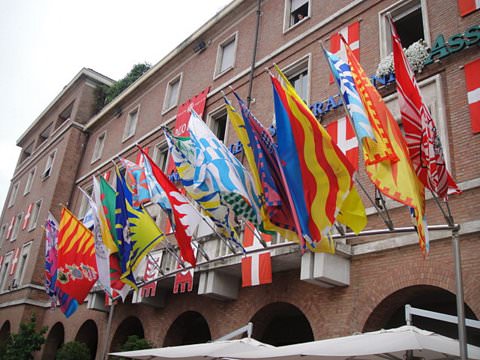 As in Siena, where a better-known Palio is held, people prepare all year for the big event. Medieval costumes are purchased or made, banners designed. Flag-flyers practice for performances that demand considerable skill, and trumpeters and drummers rehearse. Toward mid-September, excitement builds, and bets are probably placed as to which of the 21 intensely competitive districts will win the race. Some districts are from town, others in surrounding areas or villages, and each has its own flag, colors, and pride. On Thursday evenings, the flag-wavers perform in Piazza San Secondo, and on Sunday mornings, horses from each district receive a blessing in front of the parish church.
As in Siena, where a better-known Palio is held, people prepare all year for the big event. Medieval costumes are purchased or made, banners designed. Flag-flyers practice for performances that demand considerable skill, and trumpeters and drummers rehearse. Toward mid-September, excitement builds, and bets are probably placed as to which of the 21 intensely competitive districts will win the race. Some districts are from town, others in surrounding areas or villages, and each has its own flag, colors, and pride. On Thursday evenings, the flag-wavers perform in Piazza San Secondo, and on Sunday mornings, horses from each district receive a blessing in front of the parish church.
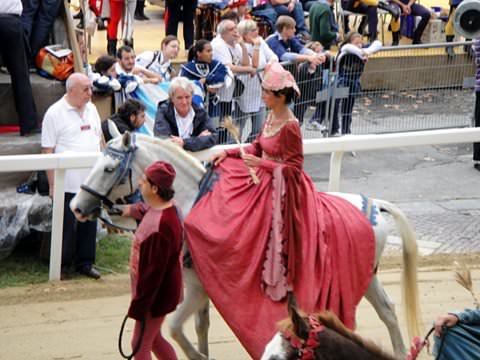 Visitors swarm in for the festivities and when we visited, on the third weekend of September, the streets, hotels, restaurants and outdoor cafes were crammed. We stopped for lunch at “Tuit,” in Eataly, in the heart of the medieval district. Asti’s Eataly is a smaller version of the massive Eataly slow-food market and artisanal food center in Turin, New York, and other cities. The meal at our sidewalk table was excellent—a big salad and fabulous Italian chocolate gelato make a perfect lunch for me—and the service swift, even on this busy day.
Visitors swarm in for the festivities and when we visited, on the third weekend of September, the streets, hotels, restaurants and outdoor cafes were crammed. We stopped for lunch at “Tuit,” in Eataly, in the heart of the medieval district. Asti’s Eataly is a smaller version of the massive Eataly slow-food market and artisanal food center in Turin, New York, and other cities. The meal at our sidewalk table was excellent—a big salad and fabulous Italian chocolate gelato make a perfect lunch for me—and the service swift, even on this busy day.
 Then we headed for the action at Piazza Cattedrale, where at least 1200 people, all dressed in elaborate medieval garb, began their procession. With trumpeters and drummers they paraded through the streets, finally entering Piazza Vittorio Alfieri. (The Palio is not held in Piazza Campo del Palio, as you might expect.) Every year, different aspects of Asti’s long history are shown in the procession: kings and queens on horseback, prisoners in chains, the Plague, cathedral-building, wine harvests—there were dozens of stories from the past. It was an extraordinary spectacle.
Then we headed for the action at Piazza Cattedrale, where at least 1200 people, all dressed in elaborate medieval garb, began their procession. With trumpeters and drummers they paraded through the streets, finally entering Piazza Vittorio Alfieri. (The Palio is not held in Piazza Campo del Palio, as you might expect.) Every year, different aspects of Asti’s long history are shown in the procession: kings and queens on horseback, prisoners in chains, the Plague, cathedral-building, wine harvests—there were dozens of stories from the past. It was an extraordinary spectacle.
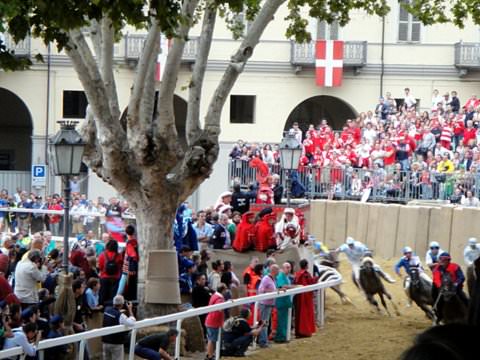 Thousands cheered as the parade circled the piazza. Those standing in the middle walked in free, while costs varied for stadium seating around the edges. Seats at the starting point sold for 83 euros (about $112) apiece. We sat in the middle, a few rows behind the mayor and dignitaries. After the procession passed by, the captain of the guards, in red regalia, rode on his horse to the mayor and received the official, ceremonial order to begin the Palio.
Thousands cheered as the parade circled the piazza. Those standing in the middle walked in free, while costs varied for stadium seating around the edges. Seats at the starting point sold for 83 euros (about $112) apiece. We sat in the middle, a few rows behind the mayor and dignitaries. After the procession passed by, the captain of the guards, in red regalia, rode on his horse to the mayor and received the official, ceremonial order to begin the Palio.
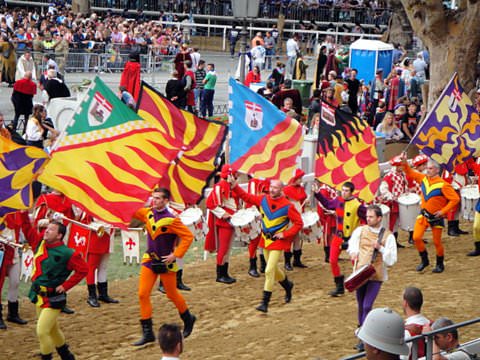 The race dates back to 1275, according to early records, and was likely a challenge between the noble families of the day. It’s been held ever since, with a few necessary breaks (wartime being the main one). The horses are ridden bareback by 21 jockeys, each representing a village or district, in three seven-horse heats, with a final race run by nine horses—the three winners from each heat. The district whose horse wins gets to keep the large banner (the “palio”) that was designed by an artist for that year. Second prize is a set of spurs, third is a symbolic bag of coins, and fourth prize is a salad with an anchovy. Yes, you read that right, it’s a bunch of lettuce. The race is won by the horse, not the jockey, and if the jockey falls off and the horse keeps going, he may well win the heat. It happened in the Palio we attended, in the second heat,
The race dates back to 1275, according to early records, and was likely a challenge between the noble families of the day. It’s been held ever since, with a few necessary breaks (wartime being the main one). The horses are ridden bareback by 21 jockeys, each representing a village or district, in three seven-horse heats, with a final race run by nine horses—the three winners from each heat. The district whose horse wins gets to keep the large banner (the “palio”) that was designed by an artist for that year. Second prize is a set of spurs, third is a symbolic bag of coins, and fourth prize is a salad with an anchovy. Yes, you read that right, it’s a bunch of lettuce. The race is won by the horse, not the jockey, and if the jockey falls off and the horse keeps going, he may well win the heat. It happened in the Palio we attended, in the second heat, 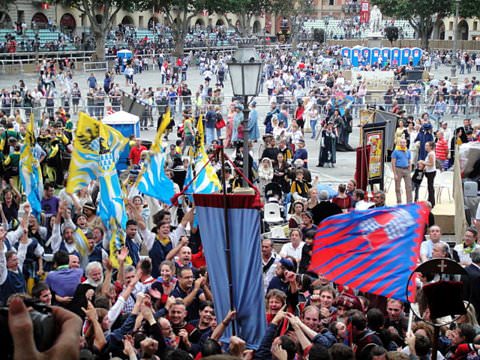 and that horse ran (with jockey) in the final.
and that horse ran (with jockey) in the final.
Before the race begins, the horses line up at a rope stretched across the track. If there’s a false start, a cannon blasts and they must line up again, with the starter on his loudspeaker yelling at the riders to get their horses in place. It took half an hour and four false starts before the first heat ran. “Why don’t they get it together?” I asked my Italian companion. She smiled. “It’s all part of the game,” she said. When there’s a false start and the cannon booms, everyone boos the jockey at fault, his own district loudest of all. Not that the jockeys actually come from the districts they represent—these are professionals, many from Sardinia, and so are the horses, all of them hired by committees who raise funds to pay for the best racers.
 When the horses at last took off, the crowd roared. The excitement was catching, and I, a foreigner who speaks little Italian and understands less, roared with the best of them. The winner of the final nine-horse race was not an Asti district, but a place that had never won before, the village of San Damiano. The winners were ecstatic. They swarmed onto the track and surrounded the jockey and horse, shouting their joy. The mayor presented the prizes, and the Palio was over. The people of Asti went out to celebrate, already planning next year’s costumes and festivities.
When the horses at last took off, the crowd roared. The excitement was catching, and I, a foreigner who speaks little Italian and understands less, roared with the best of them. The winner of the final nine-horse race was not an Asti district, but a place that had never won before, the village of San Damiano. The winners were ecstatic. They swarmed onto the track and surrounded the jockey and horse, shouting their joy. The mayor presented the prizes, and the Palio was over. The people of Asti went out to celebrate, already planning next year’s costumes and festivities.
Written by Marilyn McFarlane for EuropeUpClose.com
